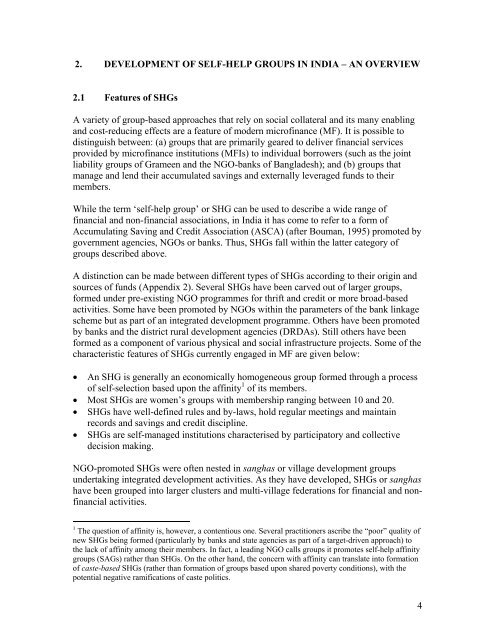Self-help Groups as Financial Intermediaries in India ... - Sa-Dhan
Self-help Groups as Financial Intermediaries in India ... - Sa-Dhan
Self-help Groups as Financial Intermediaries in India ... - Sa-Dhan
Create successful ePaper yourself
Turn your PDF publications into a flip-book with our unique Google optimized e-Paper software.
2. DEVELOPMENT OF SELF-HELP GROUPS IN INDIA – AN OVERVIEW2.1 Features of SHGsA variety of group-b<strong>as</strong>ed approaches that rely on social collateral and its many enabl<strong>in</strong>gand cost-reduc<strong>in</strong>g effects are a feature of modern microf<strong>in</strong>ance (MF). It is possible todist<strong>in</strong>guish between: (a) groups that are primarily geared to deliver f<strong>in</strong>ancial servicesprovided by microf<strong>in</strong>ance <strong>in</strong>stitutions (MFIs) to <strong>in</strong>dividual borrowers (such <strong>as</strong> the jo<strong>in</strong>tliability groups of Grameen and the NGO-banks of Bangladesh); and (b) groups thatmanage and lend their accumulated sav<strong>in</strong>gs and externally leveraged funds to theirmembers.While the term ‘self-<strong>help</strong> group’ or SHG can be used to describe a wide range off<strong>in</strong>ancial and non-f<strong>in</strong>ancial <strong>as</strong>sociations, <strong>in</strong> <strong>India</strong> it h<strong>as</strong> come to refer to a form ofAccumulat<strong>in</strong>g <strong>Sa</strong>v<strong>in</strong>g and Credit Association (ASCA) (after Bouman, 1995) promoted bygovernment agencies, NGOs or banks. Thus, SHGs fall with<strong>in</strong> the latter category ofgroups described above.A dist<strong>in</strong>ction can be made between different types of SHGs accord<strong>in</strong>g to their orig<strong>in</strong> andsources of funds (Appendix 2). Several SHGs have been carved out of larger groups,formed under pre-exist<strong>in</strong>g NGO programmes for thrift and credit or more broad-b<strong>as</strong>edactivities. Some have been promoted by NGOs with<strong>in</strong> the parameters of the bank l<strong>in</strong>kagescheme but <strong>as</strong> part of an <strong>in</strong>tegrated development programme. Others have been promotedby banks and the district rural development agencies (DRDAs). Still others have beenformed <strong>as</strong> a component of various physical and social <strong>in</strong>fr<strong>as</strong>tructure projects. Some of thecharacteristic features of SHGs currently engaged <strong>in</strong> MF are given below:• An SHG is generally an economically homogeneous group formed through a processof self-selection b<strong>as</strong>ed upon the aff<strong>in</strong>ity 1 of its members.• Most SHGs are women’s groups with membership rang<strong>in</strong>g between 10 and 20.• SHGs have well-def<strong>in</strong>ed rules and by-laws, hold regular meet<strong>in</strong>gs and ma<strong>in</strong>ta<strong>in</strong>records and sav<strong>in</strong>gs and credit discipl<strong>in</strong>e.• SHGs are self-managed <strong>in</strong>stitutions characterised by participatory and collectivedecision mak<strong>in</strong>g.NGO-promoted SHGs were often nested <strong>in</strong> sangh<strong>as</strong> or village development groupsundertak<strong>in</strong>g <strong>in</strong>tegrated development activities. As they have developed, SHGs or sangh<strong>as</strong>have been grouped <strong>in</strong>to larger clusters and multi-village federations for f<strong>in</strong>ancial and nonf<strong>in</strong>ancialactivities.1 The question of aff<strong>in</strong>ity is, however, a contentious one. Several practitioners <strong>as</strong>cribe the “poor” quality ofnew SHGs be<strong>in</strong>g formed (particularly by banks and state agencies <strong>as</strong> part of a target-driven approach) tothe lack of aff<strong>in</strong>ity among their members. In fact, a lead<strong>in</strong>g NGO calls groups it promotes self-<strong>help</strong> aff<strong>in</strong>itygroups (SAGs) rather than SHGs. On the other hand, the concern with aff<strong>in</strong>ity can translate <strong>in</strong>to formationof c<strong>as</strong>te-b<strong>as</strong>ed SHGs (rather than formation of groups b<strong>as</strong>ed upon shared poverty conditions), with thepotential negative ramifications of c<strong>as</strong>te politics.4















